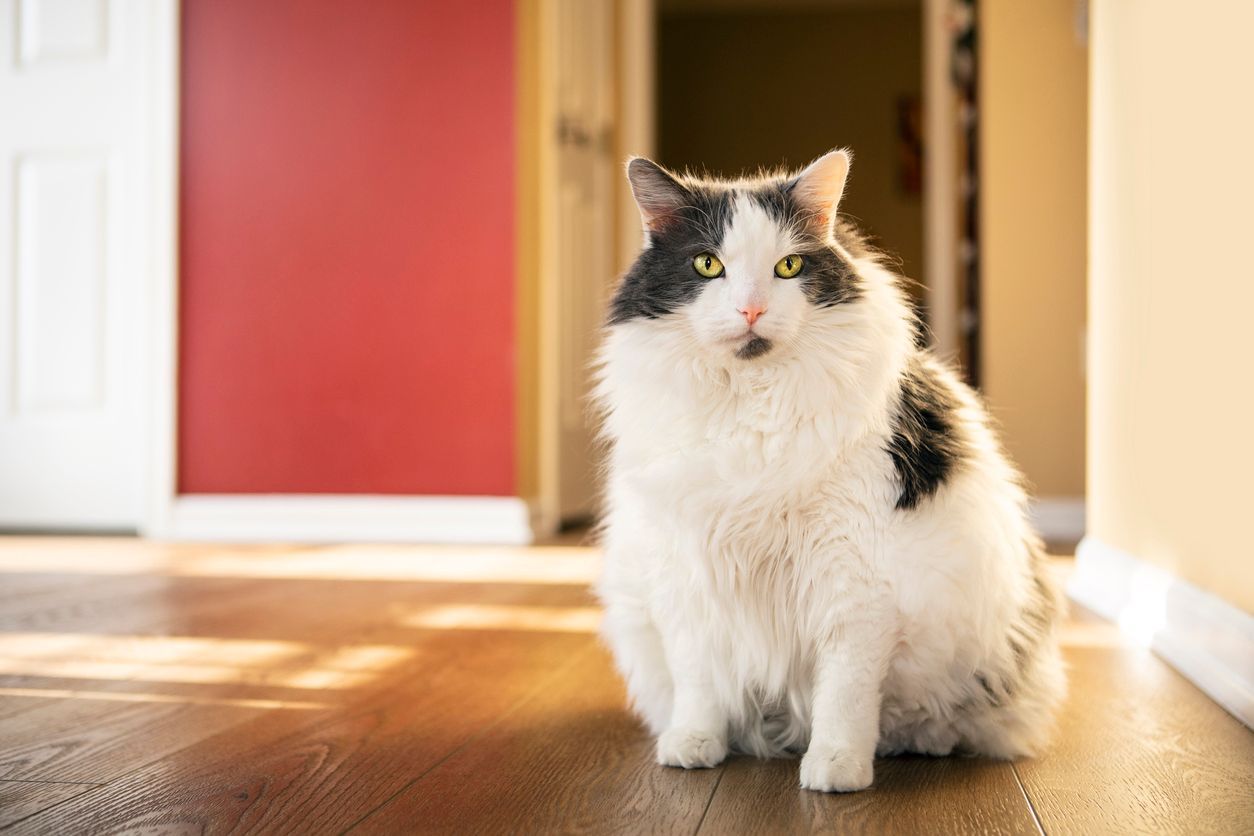How to prevent and manage obesity in cats

Obesity in cats is a growing concern for pet owners around the world. Many pet owners are under the assumption that a fat cat is a sign of happiness. In reality, an overweight cat is likely to develop life-threatening health conditions and face a lower life expectancy and quality of life. It is important for all cat owners to understand the seriousness of pet obesity. Read on to learn:
- What is obesity in cats?
- What are the health risks for obese cats?
- How is feline obesity treated?
- How can I prevent weight gain in my cat?
What is cat obesity?
Obesity is the most common nutritional disorder in cats, affecting over half of pet cats in both the United States and Canada. The condition is a chronic inflammatory disease caused by a high caloric intake that outweighs the number of calories burned day to day. A cat is defined as overweight if they carry any additional weight exceeding their ideal. Being overweight can lead to health risks even before a cat’s weight has reached a state of obesity. A cat is considered obese when it weighs 20% more than its ideal weight. Veterinarians diagnose obesity in cats through a physical exam and measuring their body condition score.
What are the risks of obesity in cats?
When cats are obese, the excess body weight puts strain on their joints and internal organs. This puts them at an increased risk for a wide range of illnesses and health conditions. Health risks of obesity in cats include:
- Diabetes mellitus
- Pancreatitis
- Joint pain and diseases, such as osteoarthritis
- Skin diseases and conditions
- Heart disease
- Cancer
- Respiratory disease and difficulty breathing
- Urinary conditions
- Liver disease
- Kidney disease
- High blood pressure
- Decreased life expectancy
When cats are obese, they may have limited mobility, preventing them from being able to exercise properly and making it even more difficult to lose excess weight. Severely obese cats cannot groom themselves properly, reach high places, and have low energy levels, all of which affects their comfort and quality of life, and causes additional stress. While some of the health conditions associated with obesity can be reversed with weight loss, many are lifelong and require prolonged treatment, impacting the quality of your cat’s life and potentially shortening their lifespan.
What cats are most likely to become obese?
In general, the development of cat obesity is caused by overconsumption of food relative to activity level. However, there are a few risk factors for obesity in cats. Cats that are more likely to gain weight include:
- Cats that are middle-aged and older
- Cats that are free-fed or have free access to food
- Cats that are inactive or have low activity levels
- Cats that are spayed or neutered
Physical activity and portion control are essential for maintaining an ideal body weight in cats, especially indoor cats. An owner’s attitude toward their cat’s weight also influences their overall health. Many cat owners feel that a fat cat is a healthy cat and increased weight implies their cat has a good quality of life. This is not the case. Being overweight or obese puts cats at risk for serious health complications.
How is obesity treated in cats?
Treatment of obesity includes decreasing caloric intake and increasing physical activity. Cats with low energy levels may benefit from short periods of physical activity multiple times a day instead of longer play periods, which will help gradually increase their energy requirements over time. For the best results, work with a veterinarian to develop a weight loss program for your cat. If your cat is having difficulty losing weight or has gained weight unexpectedly, your vet may recommend some diagnostic tests to rule out medical contributing factors.
How can I help my cat lose weight?
“Cats can overeat just like we can, causing them to gain weight," states Dr. Matt Spiegle, a veterinarian with Vetster. “Instead of offering free-choice feeding, give designated meals with measured amounts of food to track daily caloric intake.” Providing a complete and balanced diet that is meant for weight loss can help. Weight loss diets have higher nutrient density, so portions can be restricted more than a regular diet without risking nutrient deficiencies. Weight loss diets are also often lower in caloric density, which means individual portions have higher levels of protein and fiber to increase satiety and reduce begging. However, food type does not matter as much as avoiding over-intake of food and calories. Always provide clean, fresh water. Finally, know the number of calories that are in the treats you give your cat and adjust your cat’s food intake accordingly. Treats should account for no more than 10% of your pet’s daily calories.
Smaller, more frequent meals may help a cat who is used to free-choice feeding adjust to designated meal times. Increase playtime and exercise with your cat, changing available toys and activities to keep them interested and engaged. For homes with multiple cats, feed your cats in separate areas and keep food out of the reach of your obese cat. You can even use a microchip feeder that will only allow the designated cat to eat from the food bowl. Measuring the energy requirements of your individual cat will help you determine exactly how much they should be eating every day. Note that not all cups are made equal and may range in size. It is best to use a measuring cup or gram scale to accurately measure your cat’s food intake.
How can I prevent weight gain in my cat?
Obesity prevention and weight control in young cats decreases the chances of developing many health conditions later in life. Kitten growth charts can help keep track of your kitten’s body condition score as they grow and prevent them from becoming overweight at a young age. If your cat was previously obese and has reached its ideal weight, a weight maintenance diet is crucial to prevent them from regaining weight. A veterinarian may advise you to keep your cat on a weight loss diet to prevent them from rebounding. About 50% of cats who were previously overweight will rebound and regain the weight they lost.
Portion control of food using an accurate measuring cup or gram scale and physical activity are essential to maintaining an ideal weight in your cat. Stick to their scheduled feeding times and avoid excess treats. Consider using an automated feeder so your cat doesn’t see you as the primary food provider in order to avoid begging and manipulating for extra food. Avoid calorically dense human treats such as cheese that can contribute to a large percentage of your cat’s daily calories. Weigh your cat regularly and check their body condition score. Finally, keep them active by cycling through toys, providing climbing enrichment, providing puzzles for their treats and kibble, and going on outdoor walks. Cats love hunting, so puzzle feeders or hiding their food in toys or around your home is a great way to stimulate them mentally and incorporate exercise into their day. Regular vet visits also help monitor your cat’s weight and provide feedback on how to effectively incorporate weight loss strategies for your pet.
What is the ideal weight for cats?
The ideal weight for cats varies depending on age, breed, and overall size. Ultimately, a body condition score is the best way to determine if your cat is overweight. The ribs and spine in a cat of a healthy weight should be easily felt without excess fat deposits covering them or alternatively, without protruding. The waist and stomach should be tucked when viewed from the top and side. By maintaining your cat’s target weight, they will live a healthier lifestyle and stay active. If you have questions about your cat’s weight or would like to develop a weight loss program with a vet, you can book an online vet appointment at Vetster to speak to a vet from home.
FAQ - How to prevent and manage obesity in cats
What causes feline obesity?
Pet obesity is caused by the overconsumption of calories per day compared to the number of calories burned through daily exercise and physical activity. House cats often become sedentary or are free-fed, leading to weight gain. A cat’s metabolism also decreases after they are spayed or neutered, reducing their daily caloric requirements.
Are fat cats happy?
Contrary to popular belief, a fat cat is not a happy or healthy cat. Excess weight increases the likelihood of developing serious clinical conditions, such as cardiovascular disease, fatty liver disease, and diabetes. These conditions lead to a lower quality of life, decreased life expectancy, and higher veterinary bills from treating these preventable conditions.
Is it ok if my cat is overweight?
To remain healthy, all cats should maintain an ideal weight. A healthy weight will decrease the likelihood of several medical conditions and illnesses while increasing your cat’s overall lifespan and quality of life. Create a feeding plan that aims for your cat’s ideal weight with the help of a veterinarian, and stick to it to help your pet maintain a healthy weight.
How do I get my indoor cat to lose weight?
If your cat is overweight, create a weight loss goal with your vet for your cat. A specific diet for weight loss is crucial to help your cat lose weight, as a diet containing less calories and higher protein and fiber helps your cat feel full and prevents nutrient deficiency. An indoor cat’s food intake is easier to monitor compared to an outdoor cat, but their energy expenditure may be less. Play with your cat more to encourage them to exercise with toys, such as laser pointers and cat wands, which will help prevent regaining lost weight.




